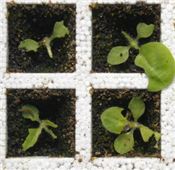Variegated Cutworms Devour Tobacco Float Plants
DR. LEE TOWNSEND
LEXINGTON, KY.
Variegated cutworm is a common and destructive pest in tobacco transplant production. The moths fly as early as March, so infestations can begin soon after seedlings begin to grow. Moths are attracted to outdoor lighting and this may be a factor in initiating infestations.
Some of the moths responding to light may enter through gaps in the plastic covering or other openings. Females lay batches of about 60 eggs on plant leaves; just a few moths can lead to significant damage. It takes a lot of nickel-sized plants to feed a growing cutworm.
Egg masses often are laid on plants in trays located along edges, near doors, or close to vent fan openings that are near moth entry points. Damage appears in hot spots that expand as cutworms destroy plants and move to other trays to feed. Variegated cutworms are active at night and burrow into the soilless media in the trays during the day. Their feeding period lasts about 3 weeks.
Identifying Variegated Cutworm
Variegated cutworm larvae are dark black to brown during their early development and generally become lighter tan to gray as they grow. A single row of light spots down the center of the back is a good recognition feature, along with blotches of color that give it a variegated appearance. These cutworms are about 1-3/4 inches long when full grown. Large cutworms are more difficult to control and may have finished most of their feeding so control measures may be too late.
The damaged plants in Figure 1, below, show typical variegated cutworm injury. Notice the ½ inch long cutworm on a leaf in the lower left cell. Variegated cutworms feed inward from the edge of the leaf, as seen in the picture. Small cutworms often leave the midrib or petiole alone.
Management
Orthene (or other acephate products), spinosad (Tracer), or several Bt products (such as Agree, Biobit, Lepinox, and XenTari) can be used as a spray for cutworm control in greenhouses and float systems. Spray areas where damage is being seen, as well as buffers around affected area because cutworms will spread outward as they feed and grow.
Acephate and spinosad can act as a stomach or contact insecticide; they control small and relatively large cutworms. Bt products are stomach poisons only, so the cutworms must eat treated foliage to be killed. Also, Bt insecticides are only effective against relatively small cutworms. Overlapping plant leaves can limit treatment application so some cutworms may not be exposed to the insecticide. ∆
DR. LEE TOWNSEND: Extension Entomologist, University of Kentucky

Figure 1. Typical variegated cutworm injury to tobacco seedlings.
(Photo: Lee Townsend)